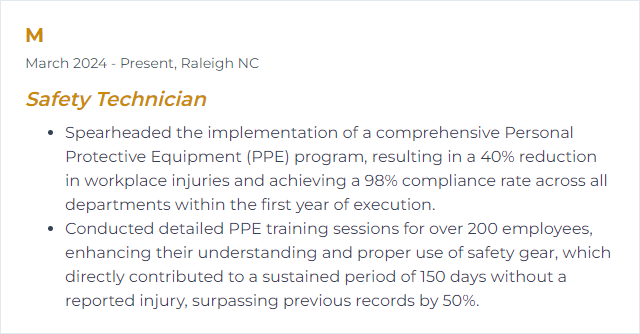Top 12 Safety Technician Skills to Put on Your Resume
A sharp resume that spotlights core Safety Technician skills does heavy lifting in a crowded job market. Blend technical know‑how with investigative grit and a steady instinct for prevention, and hiring managers notice. You’re signaling fewer incidents, tighter compliance, and a safer, smoother operation.
Safety Technician Skills
- OSHA Compliance
- HAZWOPER Certification
- Risk Assessment
- Incident Investigation
- Safety Auditing
- First Aid/CPR
- Industrial Hygiene
- Emergency Response
- MSDS/SDS Management
- Fire Safety
- Lockout/Tagout
- PPE Expertise
1. OSHA Compliance
OSHA compliance means putting the Occupational Safety and Health Administration’s standards into daily practice—finding hazards, fixing them fast, documenting thoroughly, and protecting people so work stays productive and lawful.
Why It's Important
It keeps workers healthy, reduces downtime and injuries, and shields the organization from penalties and costly disruption. For a Safety Technician, it’s the backbone of credible, consistent safety performance.
How to Improve OSHA Compliance Skills
Make it living, not paperwork:
Stay current: Track standard updates, interpretations, and enforcement trends. Build a quick-reference library and keep it pruned.
Train with intent: Short, frequent sessions beat annual marathons. Tailor to tasks, shift patterns, and languages.
Inspect with purpose: Use focused checklists, rotate inspectors, and verify corrections. Photograph, timestamp, and trend findings.
Encourage reporting: Anonymous options, zero retaliation, fast feedback. Small hazards today, fewer incidents tomorrow.
Standardize action plans: Rank risks, assign owners and deadlines, and audit completion. Close the loop, every time.
Leverage consultation: External reviews or peer exchanges reveal blind spots you don’t know you have.
Do these consistently and compliance shifts from reactive to resilient.
How to Display OSHA Compliance Skills on Your Resume

2. HAZWOPER Certification
HAZWOPER covers hazardous waste operations and emergency response training—recognition, response, decontamination, monitoring, PPE, and site control to handle dangerous substances without adding risk.
Why It's Important
It equips Safety Technicians to manage hazardous materials and emergencies confidently, protecting people, the environment, and the operation when stakes spike.
How to Improve HAZWOPER Certification Skills
Refresh annually: Complete the 8-hour refresher on time and target gaps from real incidents or drills.
Level up: Add specialized modules—spill control, air monitoring, confined space support, or incident command roles.
Practice dirty: Run hands-on scenarios with real equipment, not just slides. Don and doff, decon sequencing, air sampling under time pressure.
Cross-train: Coordinate with fire, EMS, and environmental teams to sync terminology and roles.
Document competency: Skills sheets, fit tests, and field logs speak louder than certificates.
Competence grows in the field—repeat, refine, and record.
How to Display HAZWOPER Certification Skills on Your Resume
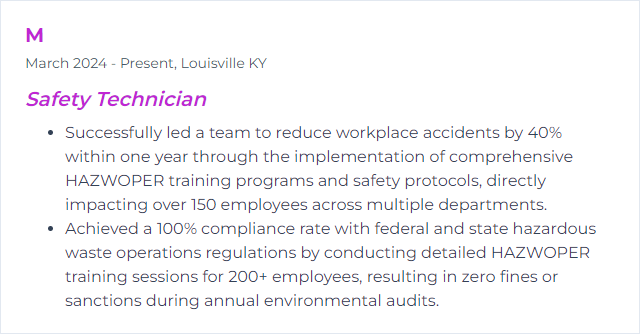
3. Risk Assessment
Risk assessment maps hazards, estimates likelihood and severity, and sets controls that actually hold under real work conditions.
Why It's Important
It prevents injuries and loss by steering energy toward the biggest risks first. Clear priorities, fewer surprises.
How to Improve Risk Assessment Skills
Know the standards: Align with recognized frameworks and update when processes, materials, or people change.
Walk the work: Observe tasks at pace, on night shift, in bad weather. Paper misses what practice reveals.
Use mixed methods: Combine qualitative judgments with quantitative data—exposure measurements, incident rates, bow-tie or barrier analysis.
Prioritize controls: Follow the hierarchy—eliminate, substitute, engineer, administer, then PPE. Design out risk where possible.
Validate and verify: Pilot controls, solicit operator feedback, and monitor leading indicators to confirm effectiveness.
Keep it living: Review after changes, near-misses, or maintenance. Version control matters.
Good assessments are clear, concise, and acted upon—otherwise they’re just shelf décor.
How to Display Risk Assessment Skills on Your Resume

4. Incident Investigation
A structured dive into what happened, why it happened, and how to keep it from happening again—beyond symptoms, down to system and human factors.
Why It's Important
It turns pain into prevention. Root causes revealed, corrective actions that actually bite, and a safer culture over time.
How to Improve Incident Investigation Skills
Stabilize first: Preserve evidence, care for people, control hazards. Then isolate the scene.
Plan the approach: Define scope, roles, and timelines. Diverse team, clear objectives.
Collect without bias: Interviews, photos, logs, training records, equipment condition—time-sequenced and corroborated.
Analyze deeply: Apply 5 Whys, fishbone, or recognized methods like TapRooT or SCAT. Separate immediate causes from latent ones.
Write for action: Facts, findings, root causes, and specific corrective actions with owners and deadlines. No blame, just learning.
Implement and verify: Track actions to closure and check effectiveness with follow-up audits.
Promote just culture: Encourage reporting and learning teams so information flows, not hides.
Consistency wins—same rigor for near-misses as for recordables.
How to Display Incident Investigation Skills on Your Resume
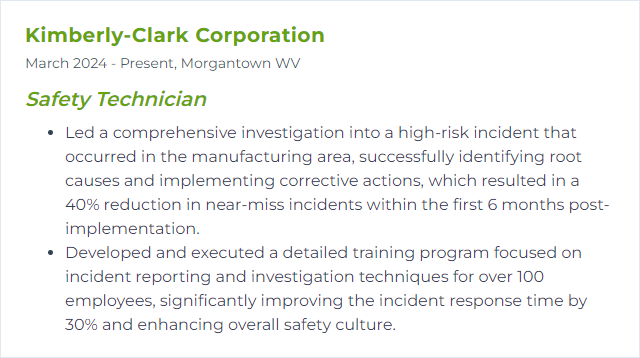
5. Safety Auditing
An evidence-based scan of programs, behaviors, and conditions to verify compliance and uncover gaps before they bite.
Why It's Important
Audits validate what’s working, expose drift, and drive continuous improvement—protecting people, property, and reputation.
How to Improve Safety Auditing Skills
Anchor to standards: Map criteria to applicable regulations and management systems (such as ISO 45001) so findings are defensible.
Sharpen technique: Calibrate auditors, use sampling plans, and blend document review with field verification.
Digitize smartly: Use tools for data capture, trending, and action tracking. Fast feedback changes behavior.
Engage the floor: Ask operators to demonstrate procedures. Observe. Listen. You’ll learn what the manual missed.
Close the loop: Prioritize findings by risk, assign owners, set due dates, and recheck. Findings without follow-through are noise.
Benchmark: Compare against peers or corporate sites to spot outliers and share wins.
Audits should feel fair, focused, and useful—not a paperwork ambush.
How to Display Safety Auditing Skills on Your Resume
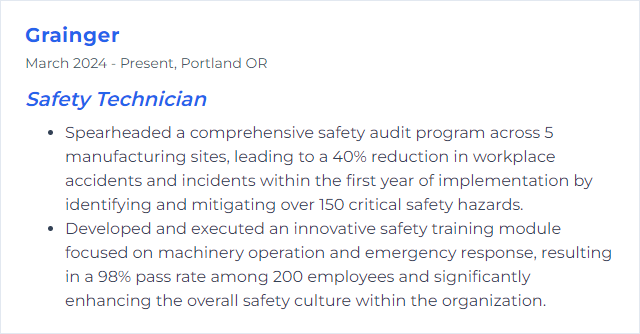
6. First Aid/CPR
Immediate care—CPR compressions, rescue breathing, AED use, bleeding control, recovery position—until medical professionals take over.
Why It's Important
Seconds matter. Quick, confident action saves lives, limits harm, and calms chaos.
How to Improve First Aid/CPR Skills
Re-certify on time: Keep credentials current (typically every two years) and note guideline updates.
Drill it: Hands-on practice with manikins and AED trainers—muscle memory beats theory.
Scenario variety: Adult, child, infant protocols; choking, shock, opioid overdose, burns—practice the edge cases.
After-action reviews: When real events happen, debrief and tighten response steps.
Maintain readiness: Check first-aid kits, AED pads and batteries, and emergency contact info. Monthly, not someday.
Confidence grows with reps and timely refreshers.
How to Display First Aid/CPR Skills on Your Resume
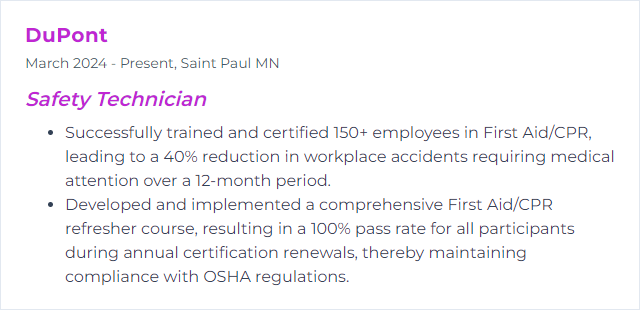
7. Industrial Hygiene
Anticipate, recognize, evaluate, and control workplace exposures—chemical, physical, biological, and ergonomic—so workers go home healthy.
Why It's Important
Good IH prevents occupational illness, chronic harm, and costly surprises. Quiet work, clean air, safe contact limits.
How to Improve Industrial Hygiene Skills
Know your limits: Understand OSHA PELs and advisory values like ACGIH TLVs. Choose the right benchmark and justify it.
Sample correctly: Calibrate instruments, use validated methods, and maintain chain of custody. Bad sampling equals bad decisions.
Assess exposure groups: Build similar exposure groups (SEGs) and sample strategically to cover variability.
Control hierarchy: Engineer first—ventilation, isolation, substitution—before administrative controls and PPE.
Train and fit-test: Respiratory protection demands medical clearance, fit testing (qualitative or quantitative), and user seal checks.
Trend and review: Compare results over time and re-check after process or material changes.
Precision matters—from pump flow rates to how a worker actually performs the task.
How to Display Industrial Hygiene Skills on Your Resume
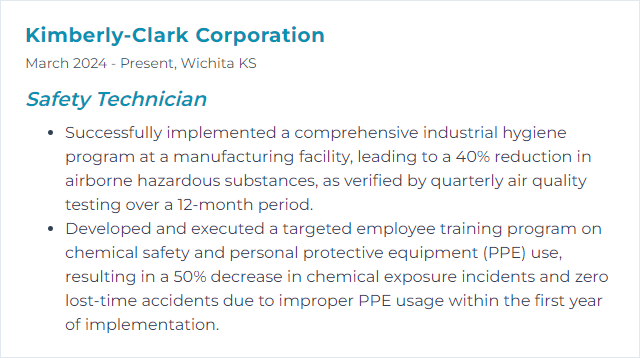
8. Emergency Response
Coordinated, immediate action when things go sideways—alarm, communicate, evacuate, treat, contain, recover, and restore.
Why It's Important
Speed and clarity prevent escalation. Lives, assets, and uptime hinge on readiness.
How to Improve Emergency Response Skills
Plan with roles: Define incident command structure, alternates, and contact trees. Simple, visible, practiced.
Drill different: Tabletop, functional, and full-scale exercises—include off-hours and bad weather. Grade realism over comfort.
Alerting and comms: Mass notifications, radios, backups. Verify reach and intelligibility.
Resource readiness: Staged spill kits, first-aid supplies, AEDs, fire equipment, and muster points clearly marked and maintained.
After-action learning: Capture what worked, fix what dragged, assign owners, and retest.
Preparedness isn’t a binder—it’s repetition and clarity under pressure.
How to Display Emergency Response Skills on Your Resume
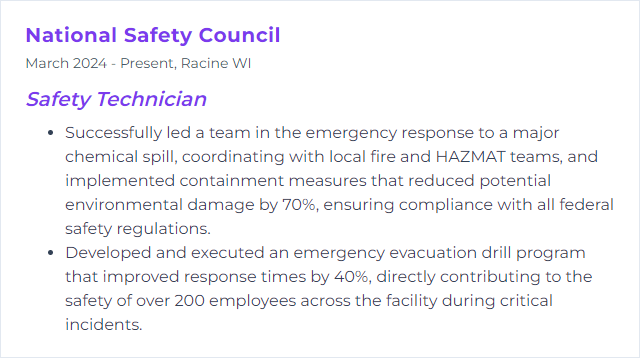
9. MSDS/SDS Management
SDS (formerly MSDS) management is the organized capture, review, and instant availability of safety data sheets for every hazardous product onsite.
Why It's Important
Workers need fast access to handling, storage, PPE, and emergency info. Accurate SDSs also support training, labeling, risk assessments, and regulatory compliance.
How to Improve MSDS/SDS Management Skills
Go digital and searchable: Centralize SDSs, index by product and manufacturer, and keep offline backups for outages.
Standardize to GHS: Ensure the 16-section format, current revision dates, and correct hazard pictograms.
Tie to inventory: Link SDSs to purchasing and chemical inventories so new products trigger review automatically.
Set a review cadence: Periodic checks for updates, discontinued products, and language accessibility.
Train for access: Show workers where SDSs live and how to read critical sections (first aid, firefighting, handling, exposure controls).
Mobile access: Quick retrieval via phone or tablet on the shop floor—response time matters.
Right-to-know: Confirm 24/7 availability and clear signage so nobody hunts during a spill.
Fast, accurate SDS access turns uncertainty into action.
How to Display MSDS/SDS Management Skills on Your Resume
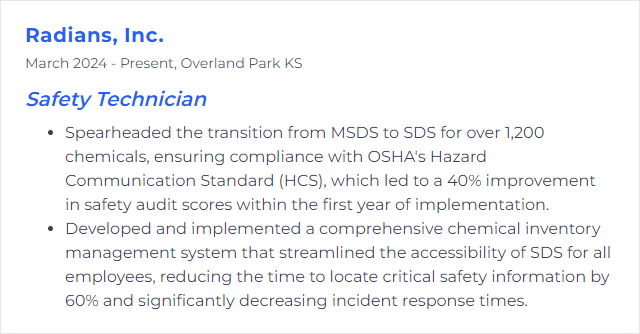
10. Fire Safety
Prevent ignition, limit fuel, detect early, and evacuate fast—then fight fires only when trained and it’s truly safe to do so.
Why It's Important
It protects life first, then property and continuity. Fires escalate in minutes; preparation buys time.
How to Improve Fire Safety Skills
Assess hazards: Hot work, electrical loads, dust, flammables—map them, mitigate them, revisit often.
Engineer defenses: Maintain alarms and suppression systems; inspect sprinklers and valves on schedule.
Extinguishers and training: Place correct classes of extinguishers, inspect monthly, and train on PASS use.
Hot work control: Permits, fire watch, and post-work monitoring to stop smolders from becoming calls to 911.
Egress certainty: Unblocked exits, lit signage, clear maps, and regular evacuation drills.
Electrical discipline: Panel clearance, cord integrity, and load management—small fixes, big impact.
Flammable storage: Proper cabinets, bonding/grounding, and capped containers. Housekeeping matters.
Culture seals it—everyone spots hazards, everyone speaks up.
How to Display Fire Safety Skills on Your Resume
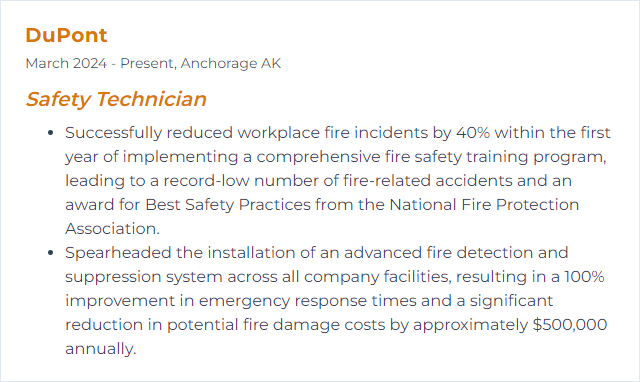
11. Lockout/Tagout
LOTO prevents the unexpected start or release of hazardous energy during servicing—mechanical, electrical, hydraulic, pneumatic, chemical, thermal, gravity.
Why It's Important
One missed energy source can be catastrophic. LOTO makes maintenance survivable.
How to Improve Lockout/Tagout Skills
Equipment-specific procedures: Clear, visual steps for each asset, including all energy isolating devices.
Train and retrain: Authorized and affected employees need role-specific instruction and practical drills.
Verify zero energy: Try-start tests, residual energy dissipation, and meter checks—never skip verification.
Group LOTO done right: Hasps, lock boxes, and shift-change protocols so no one relies on someone else’s lock.
Annual inspections: Periodic procedure audits and observed application to catch drift and close gaps.
Simple rules, strict discipline, no exceptions.
How to Display Lockout/Tagout Skills on Your Resume
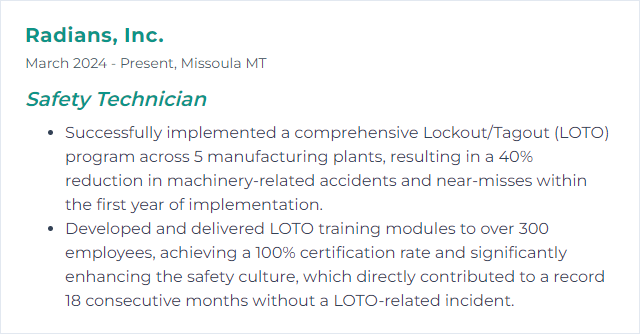
12. PPE Expertise
Knowing how to select, fit, use, maintain, and replace personal protective equipment—and when to engineer risks away instead.
Why It's Important
PPE is the last line of defense. When chosen poorly or worn wrong, it’s theater. Done right, it saves skin, lungs, eyes, and lives.
How to Improve PPE Expertise Skills
Hazard assessments: Match PPE to specific risks—chemical breakthrough times, impact ratings, APF for respirators, arc ratings for FR gear.
Fit and comfort: Respirator fit testing, glove sizing, eyewear compatibility with other PPE—comfort drives compliance.
Care and shelf life: Cleaning, storage, inspections, and timely replacement. Track lot numbers and service dates.
Train on limitations: Make clear what PPE can’t do. False confidence hurts.
Standardize vendors: Consistency simplifies training and reduces substitution errors.
Integrate with controls: PPE complements engineering and administrative layers, not replaces them.
Evidence over assumptions—test, trial, and listen to the people wearing it.
How to Display PPE Expertise Skills on Your Resume
